Abstract
Bacillus megaterium ATCC 19213 secretes a cell division-initiating “schizokinen” (SK) which accumulates during its culture cycle to a concentration inversely proportional to the iron added to a sucrose-mineral salts medium. Secreted SK was purified from culture filtrates as a red Fe (III) chelate, and a fraction with similar biological properties was obtained from whole cells. Infrared spectra of SK, and analyses of unhydrolyzed and acid-hydrolyzed preparations indicated it to be a secondary hydroxamate; visible absorption maxima of the ferric complex showed pH dependency typical of ferric monohydroxamates. Schizokinen preparations from cultures grown at “normal” and at low Fe concentrations were similar biologically and in certain of their chemical properties, but their RF values and infrared spectra suggested nonidentity. Significant lag reduction of B. megaterium was effected by 0.2 mμg of SK per ml; the Fe (III)-SK chelate and “iron-free” SK were equally effective. A 50-mμg amount produced half-maximal growth response of the siderochrome auxotroph, Arthrobacter JG-9. Schizokinen also overcame ferrimycin A inhibition of three Bacillus species. These properties relate the B. megaterium schizokinen to the trihydroxamate siderochromes, although SK appears to be a monohydroxamate.
Full text
PDF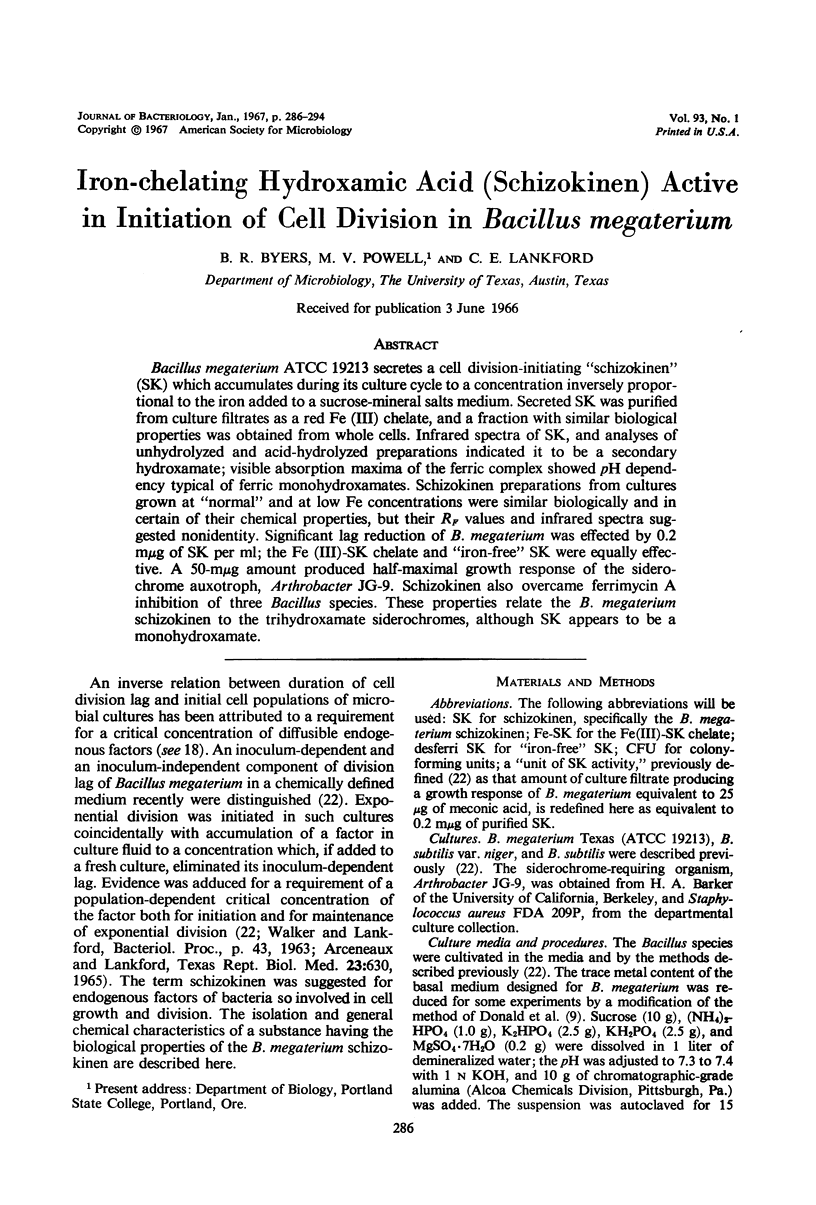
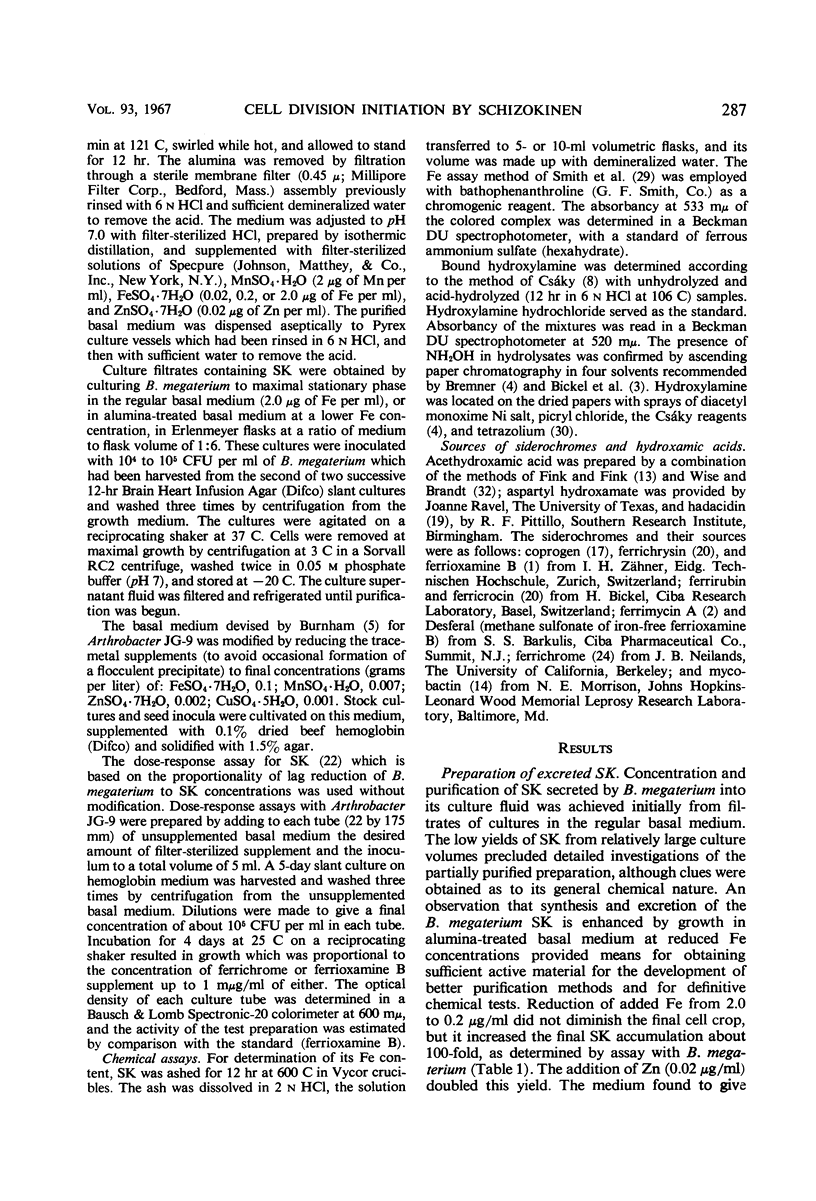
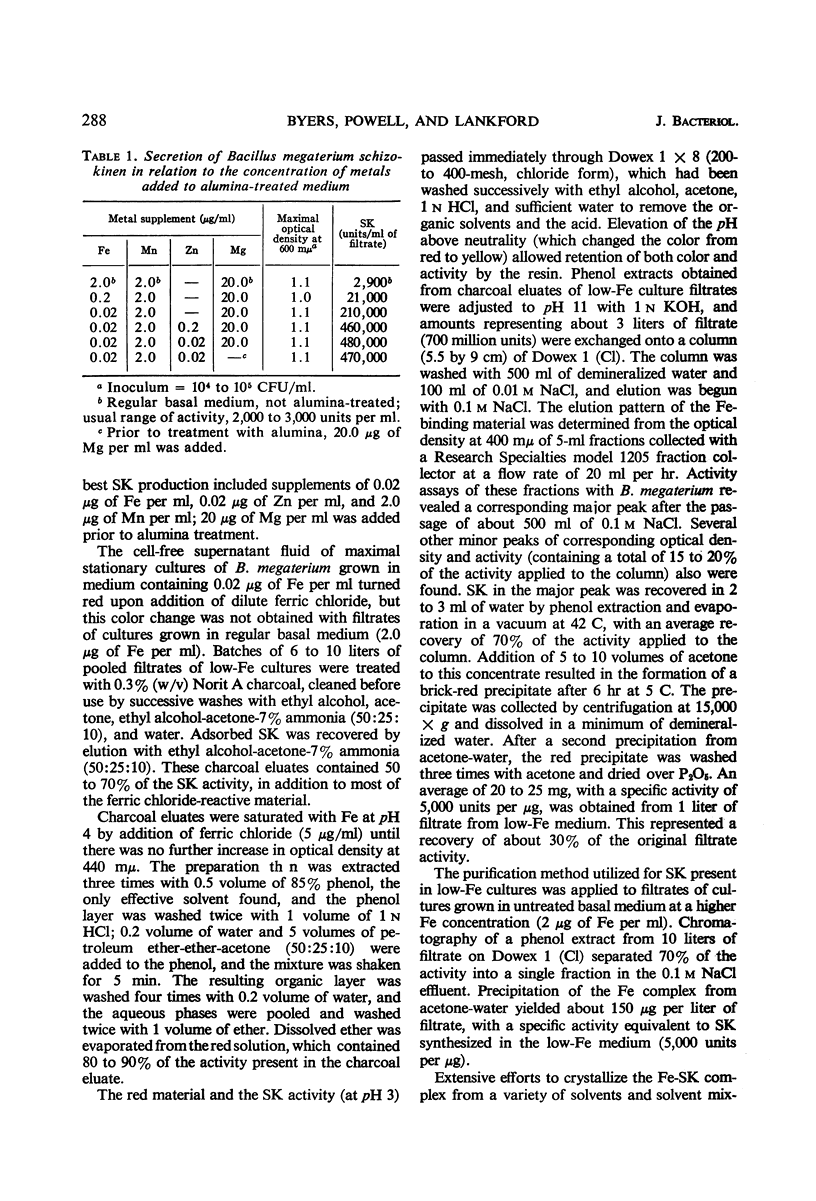

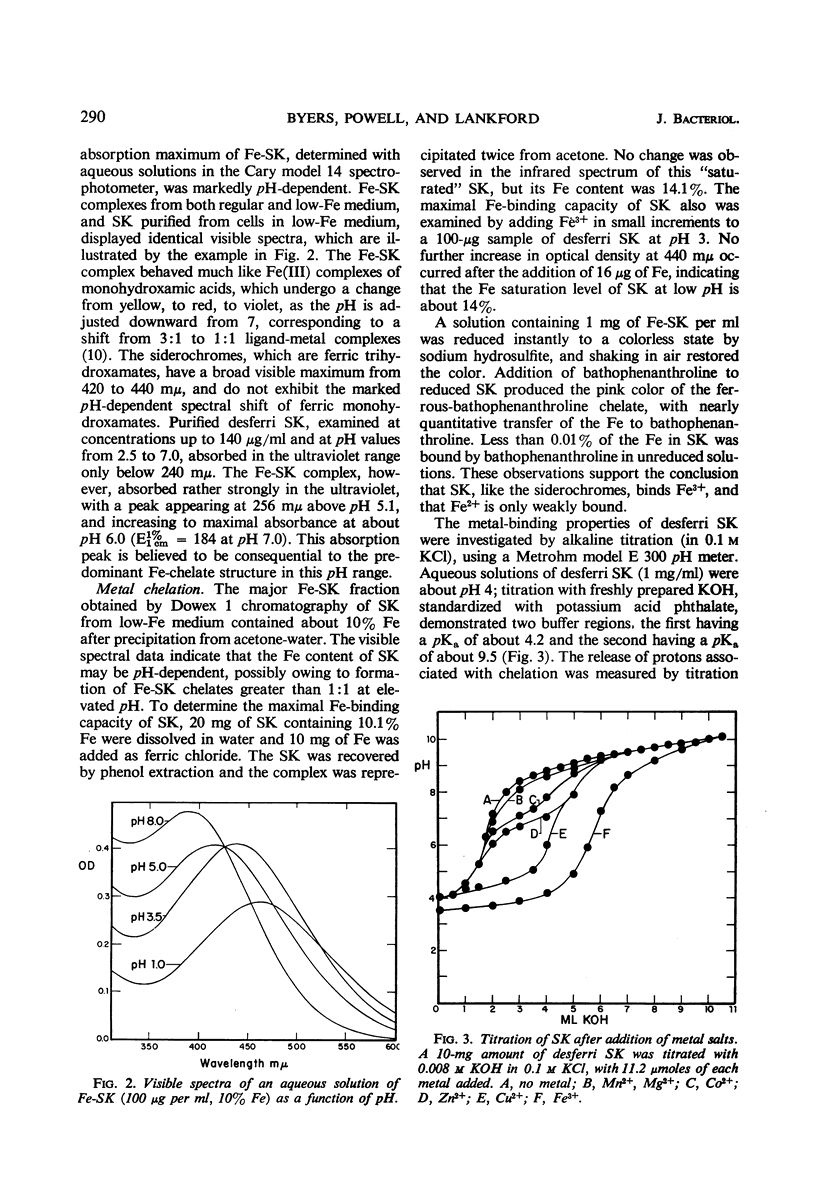
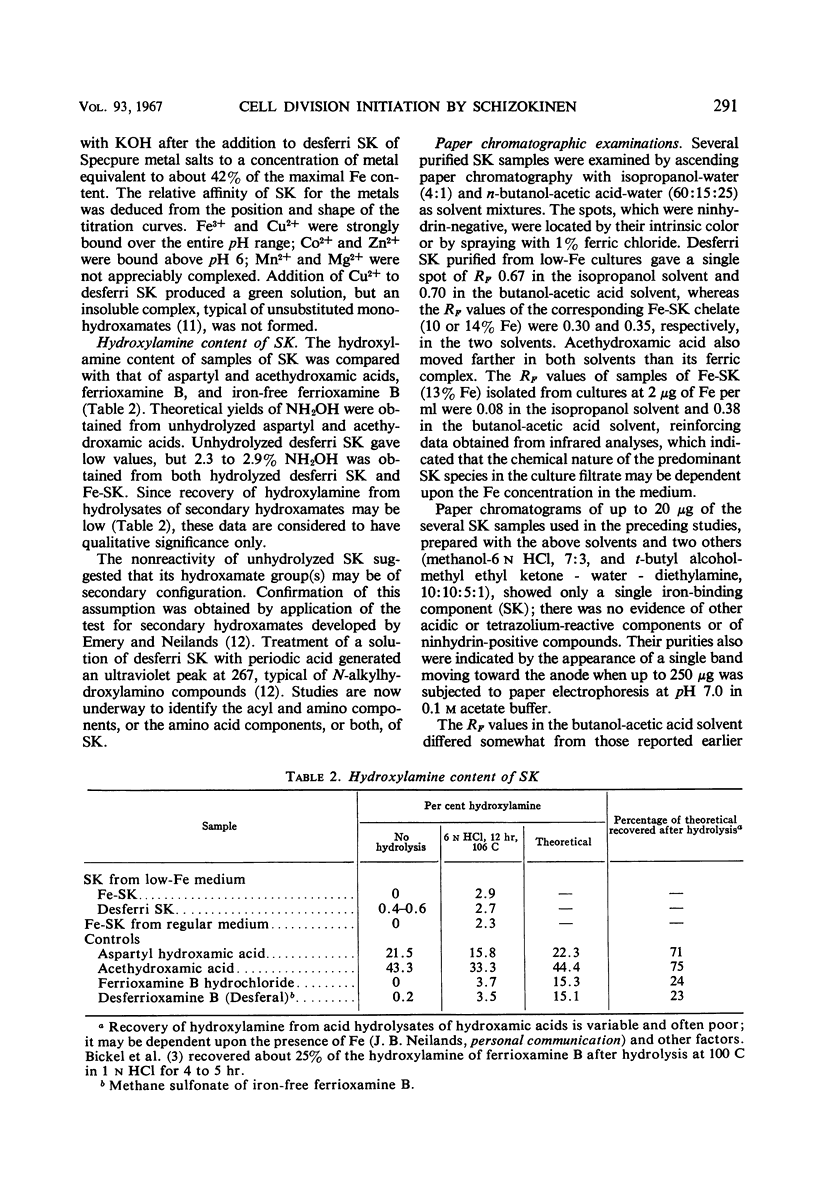
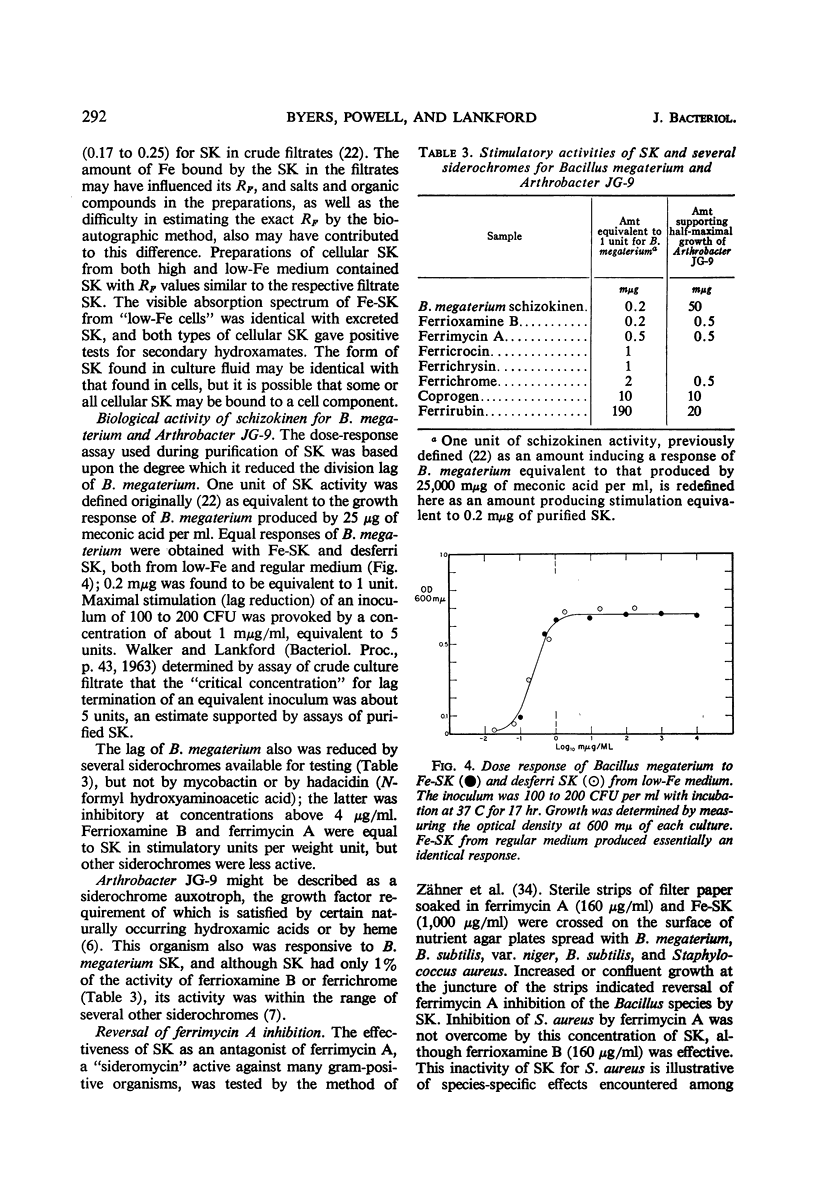
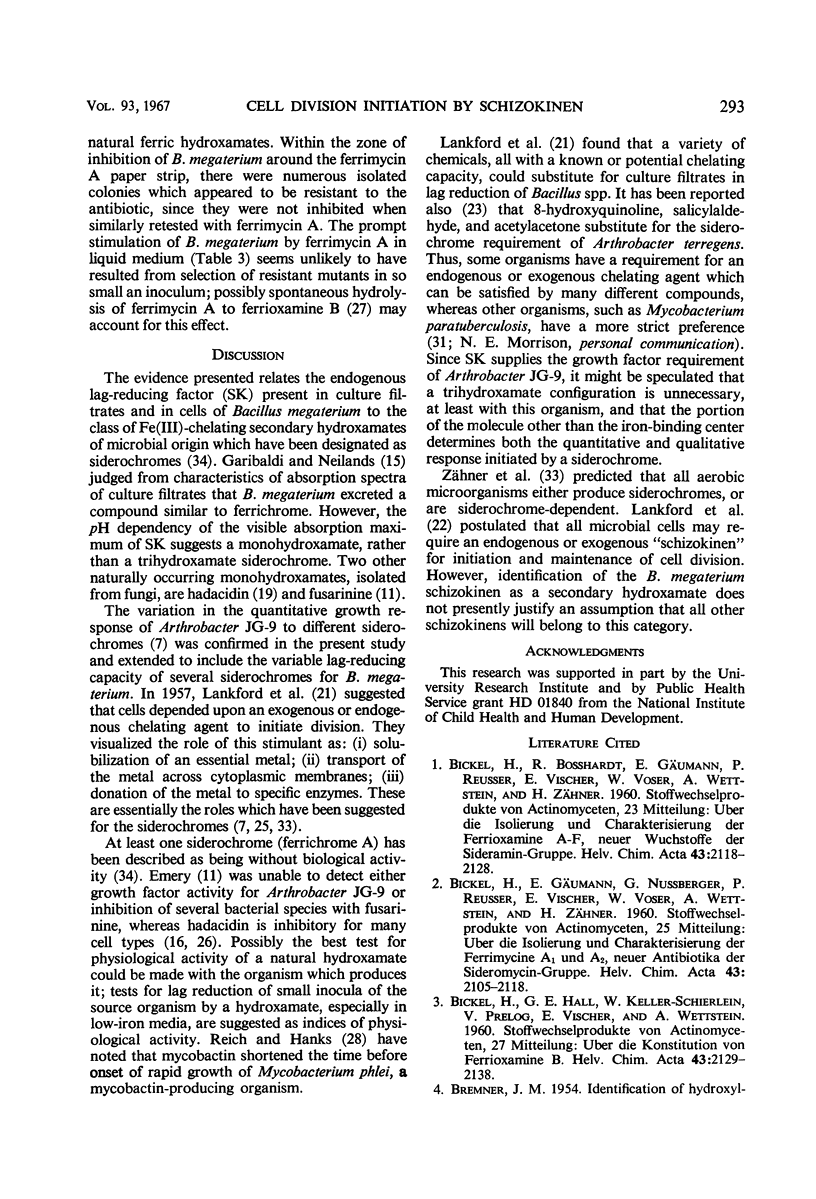
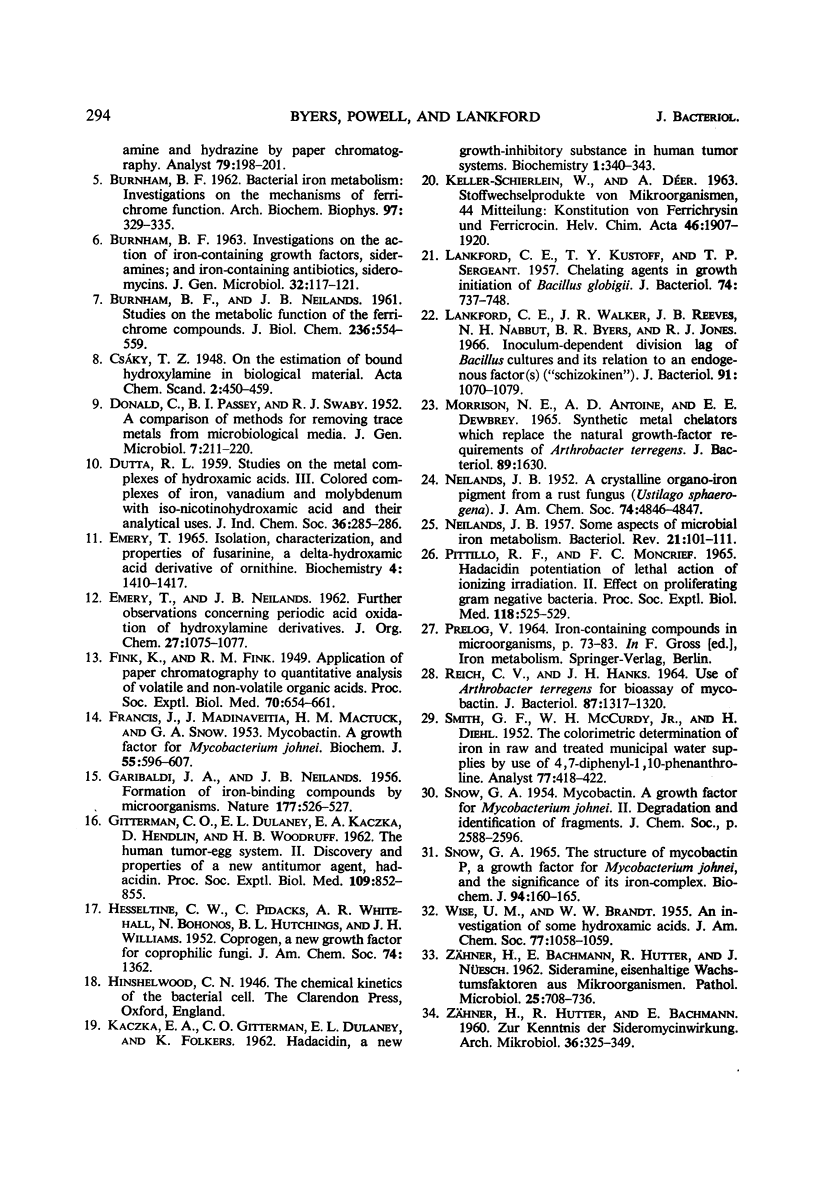
Selected References
These references are in PubMed. This may not be the complete list of references from this article.
- BURNHAM B. F. Bacterial iron metabolism: investigations on the mechanism of ferrichrome function. Arch Biochem Biophys. 1962 May;97:329–335. doi: 10.1016/0003-9861(62)90085-1. [DOI] [PubMed] [Google Scholar]
- BURNHAM B. F., NEILANDS J. B. Studies on the metabolic function of the ferrichrome compounds. J Biol Chem. 1961 Feb;236:554–559. [PubMed] [Google Scholar]
- BURNHAN B. F. INVESTIGATIONS ON THE ACTION OF THE IRON-CONTAINING GROWTH FACTORS, SIDERAMINES; AND IRON-CONTAINING ANTIBIOTICS, SIDEROMYCINS. J Gen Microbiol. 1963 Jul;32:117–121. doi: 10.1099/00221287-32-1-117. [DOI] [PubMed] [Google Scholar]
- DONALD C., PASSEY B. I., SWABY R. J. A comparison of methods for removing trace metals from microbiological media. J Gen Microbiol. 1952 Nov;7(3-4):211–220. doi: 10.1099/00221287-7-3-4-211. [DOI] [PubMed] [Google Scholar]
- Emery T. Isolation, characterization, and properties of fusarinine, a delta-hydroxamic acid derivative of ornithine. Biochemistry. 1965 Jul;4(7):1410–1417. doi: 10.1021/bi00883a028. [DOI] [PubMed] [Google Scholar]
- FRANCIS J., MACTURK H. M., MADINAVEITIA J., SNOW G. A. Mycobactin, a growth factor for Mycobacterium johnei. I. Isolation from Mycobacterium phlei. Biochem J. 1953 Nov;55(4):596–607. doi: 10.1042/bj0550596. [DOI] [PMC free article] [PubMed] [Google Scholar]
- GARIBALDI J. A., NEILANDS J. B. Formation of iron-binding compounds by micro-organisms. Nature. 1956 Mar 17;177(4507):526–527. doi: 10.1038/177526a0. [DOI] [PubMed] [Google Scholar]
- GITTERMAN C. O., DULANEY E. L., KACZKA E. A., HENDLIN D., WOODRUFF H. B. The human tumor-egg host system. II. Discovery and properties of a new antitumor agent, hadacidin. Proc Soc Exp Biol Med. 1962 Apr;109:852–855. doi: 10.3181/00379727-109-27356. [DOI] [PubMed] [Google Scholar]
- KACZKA E. A., GITTERMAN C. O., DULANEY E. L., FOLKERS K. Hadacidin, a new growth-inhibitory substance in human tumor systems. Biochemistry. 1962 Mar;1:340–343. doi: 10.1021/bi00908a022. [DOI] [PubMed] [Google Scholar]
- LANKFORD C. E., KUSTOFF T. Y., SERGEANT T. P. Chelating agents in growth initiation of Bacillus globigii. J Bacteriol. 1957 Dec;74(6):737–748. doi: 10.1128/jb.74.6.737-748.1957. [DOI] [PMC free article] [PubMed] [Google Scholar]
- Lankford C. E., Walker J. R., Reeves J. B., Nabbut N. H., Byers B. R., Jones R. J. Inoculum-dependent division lag of Bacillus cultures and its relation to an endogenous factor(s) ("schizokinen"). J Bacteriol. 1966 Mar;91(3):1070–1079. doi: 10.1128/jb.91.3.1070-1079.1966. [DOI] [PMC free article] [PubMed] [Google Scholar]
- MORRISON N. E., ANTOINE A. D., DEWBREY E. E. SYNTHETIC METAL CHELATORS WHICH REPLACE THE NATURAL GROWTH-FACTOR REQUIREMENTS OF ARTHROBACTER TERREGENS. J Bacteriol. 1965 Jun;89:1630–1630. doi: 10.1128/jb.89.6.1630-1630.1965. [DOI] [PMC free article] [PubMed] [Google Scholar]
- NEILANDS J. B. Some aspects of microbial iron metabolism. Bacteriol Rev. 1957 Jun;21(2):101–111. doi: 10.1128/br.21.2.101-111.1957. [DOI] [PMC free article] [PubMed] [Google Scholar]
- PITTILLO R. F., MONCRIEF F. C. HADACIDIN POTENTIATION OF LETHAL ACTION OF IONIZING IRRADIATION. II. EFFECT ON PROLIFERATING GRAM-NEGATIVE BACTERIA. Proc Soc Exp Biol Med. 1965 Feb;118:525–529. doi: 10.3181/00379727-118-29896. [DOI] [PubMed] [Google Scholar]
- REICH C. V., HANKS J. H. USE OF ARTHROBACTER TERREGENS FOR BIOASSAY OF MYCOBACTIN. J Bacteriol. 1964 Jun;87:1317–1320. doi: 10.1128/jb.87.6.1317-1320.1964. [DOI] [PMC free article] [PubMed] [Google Scholar]
- SNOW G. A. THE STRUCTURE OF MYCOBACTIN P, A GROWTH FACTOR FOR MYCOBACTERIUM JOHNEI, AND THE SIGNIFICANCE OF ITS IRON COMPLEX. Biochem J. 1965 Jan;94:160–165. doi: 10.1042/bj0940160. [DOI] [PMC free article] [PubMed] [Google Scholar]
- ZAEHNER H., HUETTER R., BACHMANN E. [Metabolites of Actinomycetes. Part 23. On a study of the effect of sideromycin]. Arch Mikrobiol. 1960;36:325–349. [PubMed] [Google Scholar]
- ZAEHNER H., von BACHMANN M., HUETTER R., NUESCH J. [Sideramines, iron-containing growth factors from micro-organisms]. Pathol Microbiol (Basel) 1962;25:708–736. [PubMed] [Google Scholar]


